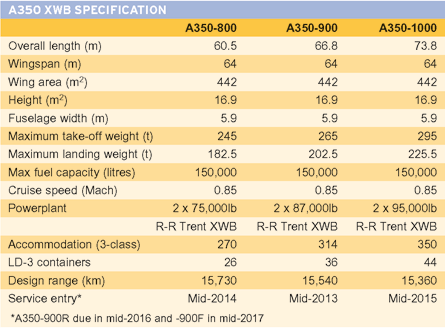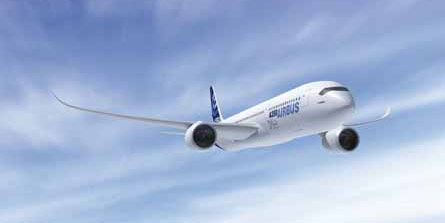With its industrial launch secured, Toulouse releases more details of the new twinjet that will take on the 787
Airbus still has a number of loose ends to tie up on the design of the A350 XWB in the coming months, as it prepares to go into battle with a definitive specification for the new twinjet to overhaul the huge sales lead that the Boeing 787 has generated. These include finalising the structural configuration, securing a second engine option to accompany the agreement already signed with Rolls-Royce, and agreeing the allocation of work and build responsibility.
|
|---|
Airbus is convinced that it has now defined the ultimate long-range twinjet in the A350 XWB family, and is ready to take on Boeing's 787 |
The airframer released a more definitive specification for the new three-model €10 billion ($13.3 billion) twinjet family last week at the industrial launch briefing in Paris than it did at the original unveiling at Farnborough in July - for example there are now some wing dimensions and more structural details. However Airbus executive vice-president programmes Tom Williams says the design freeze milestone, dubbed "main gate 7" (M7), is not due until late 2008, around six months later than when the XWB was first announced. "We have just passed 'M3', which enabled us to lock down the definition of the aircraft. M7 is scheduled for late 2008."
This illustrates how much time Airbus has lost through the rethink on what the A350 should be, as the old design was just months away from design freeze when work was suspended in early 2006.
Since Farnborough, Airbus has as expected delayed the service-entry target dates for each of the A350 models by another year so that the first model, the 314 seat -900, is not due to make is debut until mid-2013, while the 270-seat -800 and 350-seat -1000 will follow 12 and 24 months after the -900. Extended-range and freighter versions of the -900 will follow in 2016 and 2017.
The A350 has an all-new fuselage that is 25cm (10in) wider than the A330/A340's, and Airbus has completely revised its construction with large-scale use of carbonfibre. Dubbed a "hybrid fuselage" structure, it comprises carbonfibre skin panels, doublers, joints and stringers, and aluminium frames. Williams says this construction concept, which is applied to what is effectively the parallel fuselage section between the nose and aft sections, offers "the lowest overall weight for structural performance, electrical conduction, crashworthiness and repairability". He adds that while the rear fuselage section will be carbonfibre like the Airbus España-produced item for the A380, the construction of the nose section has not been finalised, with carbonfibre and metal both still being evaluated. "If we go with carbonfibre, we'd produce it as a single piece," says Williams.
Airbus plans to produce the parallel fuselage in three sections - forward, centre and aft - which on the A350-900 will be 13m, 18m and 16m long, respectively. Each section will have four long carbonfibre fuselage skin panels (top, bottom and two sides - see graphic), which will be attached to the aluminium frames.

"The lay-up and skin thickness of each panel will be optimised for local loading requirements," says Williams, who adds that the design avoids the need for titanium frames that Boeing has to use for the 787. The rival twinjet's fuselage is constructed in complete sections in large autoclaves, and Airbus says that the four-shell concept contributes to the A350's 2% lower empty weight per seat compared with the 787.
Although Williams denies that the A350's construction method has any major impact on the complexity of the build process, he acknowledges that there will be additional lap joints to be installed, but "we'll do this with a reasonable level of automation".
The lack of a choice of engine suppliers has still not been overcome - R-R remains the only manufacturer to have signed up to be on the A350. Airbus is adamant that it is close to finalising a deal with General Electric to put the GEnx on board the A350, but whatever happens, R-R will be the lead engine supplier for service entry - the reverse of the situation with the previous A350, where GE was in front. "We want GE on board, but the ball is in their court - and the train is leaving the station," says Airbus chief operating officer customers John Leahy.

The engine switch-around has left original A350 customers who signed for the GEnx-powered version facing some renegotiating if they wish to remain early customers for the new model.
Andries says that the GEnx would be offered for the A350 at a rating of 87,000lb thrust (387kN). This would match the Trent XWB, which R-R is optimising at this rating for the A350-900, and from which it will offer a derate to 75,000lb for the -800.
However, while GE will derate its GEnx offering similarly for the -800, it is not prepared to join R-R on the A350-1000 with a 95,000lb-thrust version. Airbus says that the higher-thrust Trent will "share a common core" with the lower-thrust engines, but does not specify whether any major changes will be required to the engine to power the largest A350 variant.
Source: Flight International
























